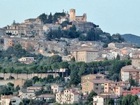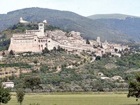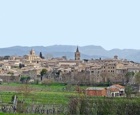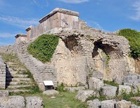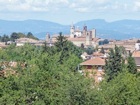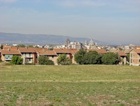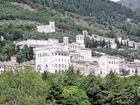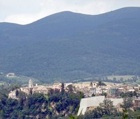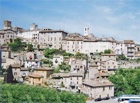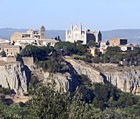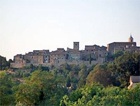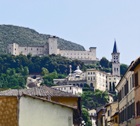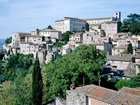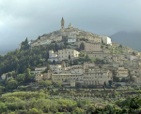

Amelia
Amelia is an ancient walled city that is easily reached from Narni. Its star attraction is the famous statue of Germanicus in the Museo Archeologico. It also boasts a panel in the Pinacoteca by the important artist, Pier Matteo d’ Amelia.
Assisi
You can reach Assisi easily by train and bus from Rome or from nearby Perugia. It also boasts an airport! You really should try to stay at least one night here, rather than joining the hordes of day trippers. There is much to interest you in this lovely medieval city, even after you have fully explored the splendours of San Francesco.
Bettona
You can reach the interesting town of Bettona by bus from Perugia or Assisi. However, it is probably easier to take a taxi. You need only a few hours to see the main sites (including the excellent Pinacoteca and Museo Civico) and to walk around the city walls.
Bevagna
The town of Bevagna is easily reached by bus from Foligno. This was an important Roman municipium and a number of interesting Roman structures survive. It also has a fine central piazza that contains two beautiful Romanesque churches.
Carsulae
The ruins of the Roman municipium of Carsulae can be visited as a day trip from Terni. (There is no evidence that Carsulae was ever a diocese. However, hagiographical sources refer to St Volusianus as a priest here in the reign of the Emperor Julian the Apostate (361-3).)
Cesi
The interesting town of Cesi and the nearby remains of an ancient temple at Torre Monte Maggiore can be visited as a drive from Terni.
Città di Castello
Città di Castello, near the border with Tuscany, is the largest city in the Upper Tiber Valley. It was a surprisingly vibrant centre of Renaissance art. Despite the fact that the most important of these works (not least three altarpieces by the young Raphael) have been dispersed, it still boasts the finest art collection in Umbria outside Perugia.
Foligno
Foligno makes an excellent base for touring central Umbria. Its lovely central square has now emerged from the scaffolding that encased much of it after the earthquake of 1997. Palazzo Trinci is the star attraction, and the Pinacoteca there gives you an extraordinary overview of the vibrant art of the city in the 15th century. Make sure that you also visit Santa Maria Infraportas, Santa Maria in Campis and the ex-church of San Domenico.
Gualdo Tadino
You can reach Gualdo Tadino by bus from Perugia or Gubbio. It has suffered badly from earthquakes and insensitive redevelopment, but much remains to interest you, including: remains from the ancient Umbrian settlement and of its Roman successor; walks on Monte Serrasanta, with its rich religious heritage; and the magnificent Rocca Flea, which houses a small but important archeological collection and a fine art collection that includes many examples of the work of Matteo da Gualdo.
Gubbio
Gubbio is an architectural treasure and still preserves important reminders of its Roman and Pre-Roman history. The best way to get there is by bus from Perugia.
Massa Martana
You can reach Massa Martana by bus from Todi. Alternatively, the train from Todi takes you to the station some 8 km below the town, which is near the site of the original Roman settlement. The Christian catacomb at nearby Villa San Faustino contained some 300 graves (ca. 300) that must have served the Christian community of Civitas Martana.
Montefalco
You can reach the lovely hilltop town of Montefalco by bus from Foligno. It has lots to detain you, including some great places in which to enjoy the Sagrantino for which it is famed. Do not miss the frescoes of San Francesco and the important art collection in the Pinacoteca there.
Narni
Accommodation in Narni is limited, but it has excellent connections by train or bus. It is a fascinating hill town with an interesting cathedral and a surprising amount of Renaissance art.
Nocera Umbra
Norcia
Orvieto
Orvieto has excellent rail links to Florence and Rome. It enjoys a spectacular site on a cylindrical cliff that was occupied in Etruscan times.The city fathers sought out the leading Italian artists to adorn the Duomo from the late 13th century. The frescoes of the Cappella Nuovea there by Luca Signorelli inspired Michael Angelo’s Last Judgement in the Sistine Chapel.
This compact city is home to a surprising number of good hotels and restaurants, and there is of course the famous Orvieto Classico.
Otricoli
The easiest way to get to Otricoli is by bus from Terni or Narni. The present city stands on the site of the Umbrian settlement of Ocar. Do not miss the church of Santa Maria Assunta. You can also visit the remains of Roman Ocriculum on the banks of the Tiber, slightly to the south.
Perugia
Perugia, the capital of Umbria, was actually an Etruscan rather than an Umbrian city. It is now a bustling university city with an airport and excellent rail and road links. Both the Galleria Nazionale dell’ Umbria (art gallery) and the Museo Archeologico Nazionale dell' Umbria (archeological museum) are outstanding.
Spello
Spello is easily reached by train from Foligno or Perugia. You could see it in a day, but it really deserves more time and is in any case a nice place to stay, with good hotels.
Spoleto
Spoleto is a lovely hill town with excellent rail links to Rome, Foligno and Perugia. Do not miss the Museo Nazionale del Ducato di Spoleto in the Rocca Albornoziana or the Duomo, with frescos by Filippo Lippi and Pintoricchio.
Terni
Terni is the provincial capital in the south of Umbria. It is now a modern city with excellent transport links. The purpose-built museum complex known as the Centro Arti Opificio Siri (c.a.o.s.) in the ex-Opificio Siri contains three important museums: the Museo Archeologico; the Museo d' Arte Moderna e Contemporanea "Aurelio De Felice"; and the small but important collection of the Pinacoteca. Don't miss the frescoes (ca. 1449) of the Last Judgement in the Cappella Paradisi of San Francesco, which are attributed to Bartolomeo di Tommaso.
Todi
Trevi
Trevi is a lovely hill town that is best reached by bus from Foligno. You can see most things in a day, but it is also worth a longer stay.
Return to the home page: Umbria
